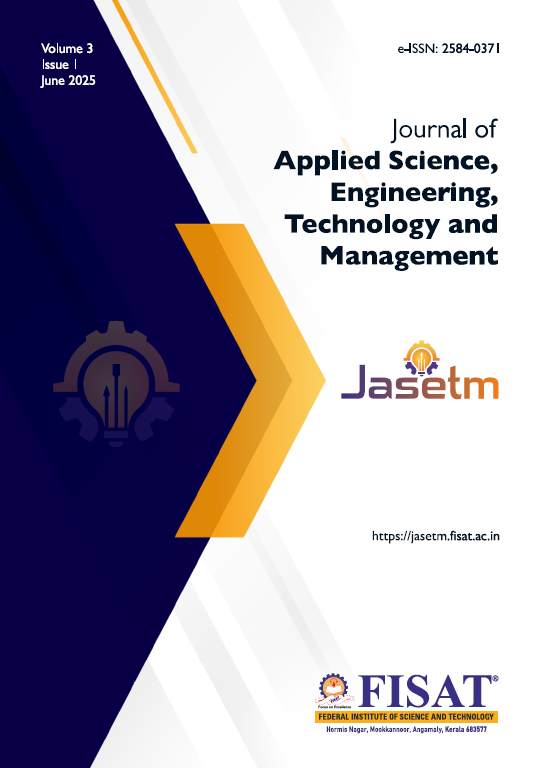Landslide Susceptibility Mapping using CNN
DOI:
https://doi.org/10.61779/jasetm.v3i1.6Keywords:
Landslide Susceptibility Mapping (LSM), Convolutional Neural Networks (CNN),, Landslide Inventory,, Machine Learning,, Disaster Risk ReductionAbstract
Landslide Susceptibility Mapping (LSM) is crucial for identifying regions at risk of landslides, which aids in disaster risk reduction and sustainable land-use planning. Traditional Landslide Susceptibility Mapping methods often rely on complex models needing extensive computational resources, limiting their real-time applicability, especially in remote settings. This study presents an innovative data-driven Landslide Susceptibility Mapping framework that utilizes Convolutional Neural Networks (CNN) to improve mapping efficiency. The Thrissur district in the Western Ghats of Kerala, India, was selected due to its high landslide vulnerability. According to the Landslide Atlas of India (2023), Thrissur is the third most landslide-prone district, facing risks from intense rainfall, rugged terrain, and human activities. This research aims to develop a streamlined and accurate Landslide Susceptibility Mapping framework. A historical landslide inventory was compiled, splitting the data into training (80%) and validation (20%) sets. Various conditioning factors, including topographic, environmental, geological, and proximity variables, are used. A CNN model was then developed and trained, producing a high-resolution landslide susceptibility map with a lightweight architecture suitable for edge device integration. The model exhibited high predictive accuracy, with an Area Under the Curve (AUC) score of 0.987 and a Root Mean Square Error (RMSE) of 0.174. These results highlight the model's effectiveness, offering valuable insights for sustainable land management and disaster mitigation in landslide-prone areas. This research significantly advances Landslide Susceptibility Mapping by combining machine learning with practical applications for environmental risk management. Future work will aim to enhance the framework's scalability and integration into real-time monitoring systems.
References
Yi, Y., Zhang, Z., Zhang, W., Jia, H., & Zhang, J., “Landslide susceptibility mapping using multiscale sampling strategy and convolutional neural network: A case study in Jiuzhaigou region,” CATENA, vol. 195, 104851, 2020.
Wang, Y., Chen, W., & Hong, H., “Landslide susceptibility mapping using convolutional neural networks and DEM-derived factors,” Environmental Earth Sciences, vol. 79, no. 9, pp. 1–13, September 2020.
Lokesh, P., Madhesh, C., Mathew, A., & Shekar, P. R., “Machine learning and deep learning-based landslide susceptibility mapping using geospatial techniques in Wayanad, Kerala state, India,” HydroResearch, vol. 8, pp. 113–126, 2025.
Ngo, P. T. T., Panahi, M., Khosravi, K., Ghorbanzadeh, O., Kariminejad, N., Cerda, A., & Lee, S. (2021). Evaluation of deep learning algorithms for national scale landslide susceptibility mapping of Iran. Geoscience Frontiers, 12(1), 505–519.
Bragagnolo, L., Da Silva, R., & Grzybowski, J., “Artificial neural network ensembles applied to the mapping of landslide susceptibility,” CATENA, vol. 184, 104240, 2019.
Fang, Z., Wang, Y., Peng, L., & Hong, H., “Integration of convolutional neural network and conventional machine learning classifiers for landslide susceptibility mapping,” Computers & Geosciences, vol. 139, 104470, 2020.
Ghiasi, V., Mahmoodi, A., & Yousefi, M., “Landslide risk potential mapping by using continuously - weighted spatial criteria and convolution artificial neural network,” Scientia Iranica, 2023.
Agboola, G., Beni, L. H., Elbayoumi, T., & Thompson, G. (2024). Optimizing landslide susceptibility mapping using machine learning and geospatial techniques. Ecological Informatics, 81, 102583.
Panchal, S., & Shrivastava, A. K. (2022). Landslide hazard assessment using analytic hierarchy process (AHP): A case study of National Highway 5 in India. Ain Shams Engineering Journal, 13(1), 101626.
Sonker, I., Tripathi, J. N., & Swarnim. (2021). Remote sensing and GIS-based landslide susceptibility mapping using frequency ratio method in Sikkim Himalaya. Natural Hazards, 109(1), 575–601.
Downloads
Published
How to Cite
Issue
Section
License
Copyright (c) 2025 Anu Mary Charly, Smitha Mohan K, Lekshmy Raghavan P

This work is licensed under a Creative Commons Attribution 4.0 International License.
Authors retain copyright and grant the journal right of first publication with the work simultaneously licensed under a Creative Commons Attribution License that allows others to share the work with an acknowledgement of the work's authorship and initial publication in this journal.
Authors are permitted and encouraged to post their work online (e.g., in institutional repositories or on their website) after the acceptance, with an acknowledgement of its initial publication in this journal, as it can lead to productive exchanges, as well as earlier and greater citation of published work.






